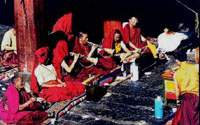
The festival of Losar, celebration of the New Year, is a major event in the Tibetan calendar.
Losar is the New Year festival of the Mahayana Buddhists. The New Years festival falls on the 25th day of the 10th month of the Tibetan calendar. Celebrated over a week, it is a feast of thanksgiving. An interesting folk tale offers to explain why the New Year festival falls at the end of Dawa Chuchipha and not at the end of the twelfth month, as is customary.
Singe Namgyar was an ancient king of Ladakh. He decided to attack Skardo (now in Pakistan). Since the date of his eventual return was uncertain, he chose to celebrate the important festival of Losar before leaving for the battle field, as it was considered obligatory for all family members to be present at the feast. This happened in the 11th month, and the tradition has carried on ever since it falls at the time when the larders are stocked full with grain and meat that is expected to last for the two long snow-bound months of winter, when no work is possible.
However, before the coming of a new year can be celebrated, unfinished business and unhappy memories must be dealt with. And so, on the 29th day of the last month in the old year, there is a festival called Gutor, in which everyone whitewashes and cleans their houses. The last day of the old year is spent preparing for the New Year. People go to monasteries to make offerings, and to participate in the ceremonies conducted during the day. Many rituals take place that are designed to chase away any evil spirits. One of these is a play in which the lamas perform masked dances to symbolize the triumph of good over evil. New Year's Eve is Lu Yugpa, an opportunity to banish evil spirits from the old year and clear the way for starting the new year right.
At dawn on New Year's Day, Tibetans visit monasteries, shrines, and stupas to make offerings. Colorful new prayer flags are hung out over each home and the smell of incense wafts through the villages. Then families venture out to drink the new year's chang (unhopped beer) with friends, to picnic in the parks and meadows, or to watch an archery tourney. There is great merriment and revelry as people thank the gods and pay homage to their ancestors for providing abundant food. The festivities are spread over almost a fortnight. During the first four days of the festival, there are a series of private family feasts.
The lamas are the initiators of the rites and play the main role, but the entire village participates. The residents of each little township decorate their houses with flour paintings of the sun and the moon. They also make offerings to the moon asking for happiness in life, in the New Year, on New Year's day and in the stars for the future. Lamps lit with mustard oil illuminate the house at night. All the members of a family are expected to stay at home for the New Year celebrations and eat a bread called tab-zan. Made of parched barley dough kneaded in mustard oil, the tab-zan is an essential offering to the family deity.
Devotees journey to the Jokhang temple in Lhasa to donate yak butter that keeps the lamps burning well into the year. At Barkor Plaza the giant incense burners work overtime to handle hundreds of people queued up to throw in their offerings of juniper branches. New sculptures of yak butter and tsampa (roasted barley flour) are displayed. Made by the lamas, the sculptures depict deities and Buddhist scenes, and will be unveiled at the Butter Sculpture Festival at the first full moon of the year (15 days after New Year's Day).
